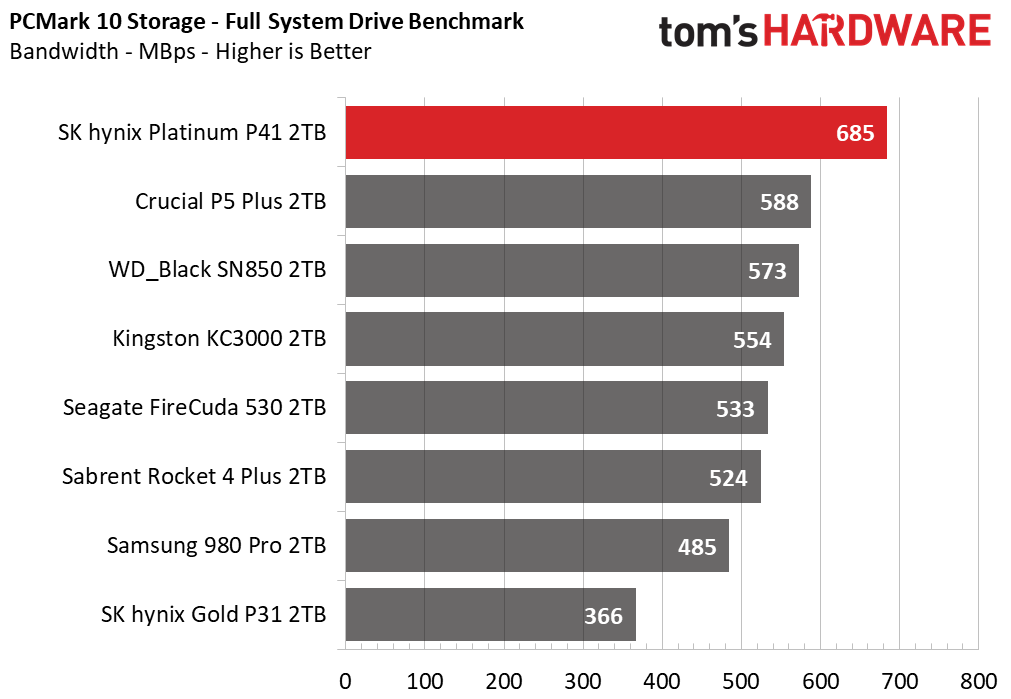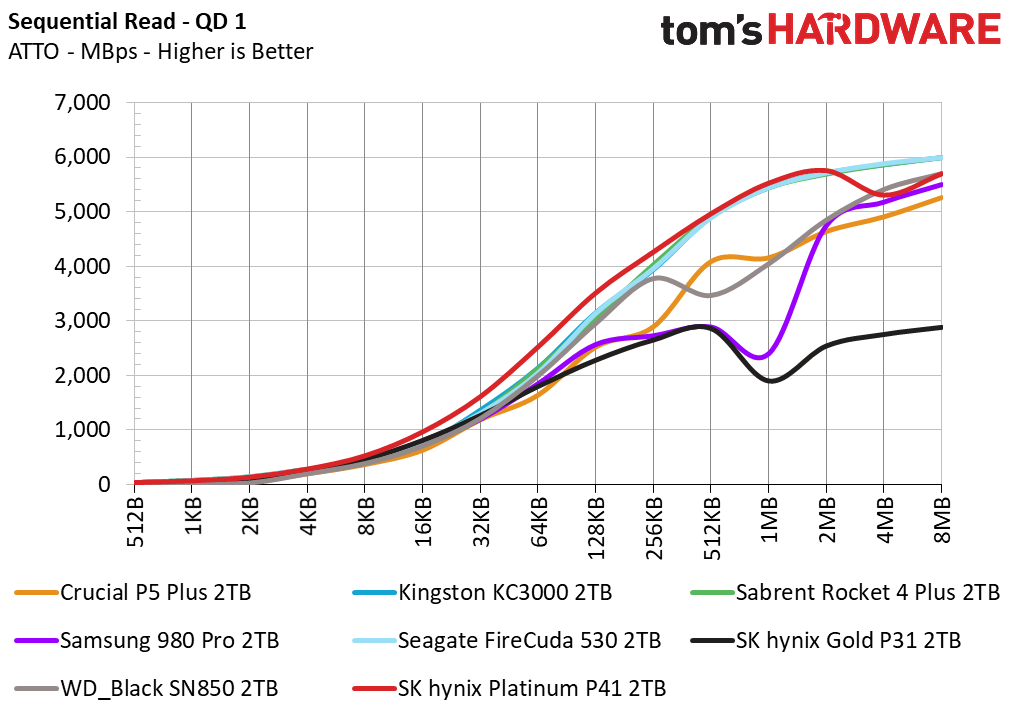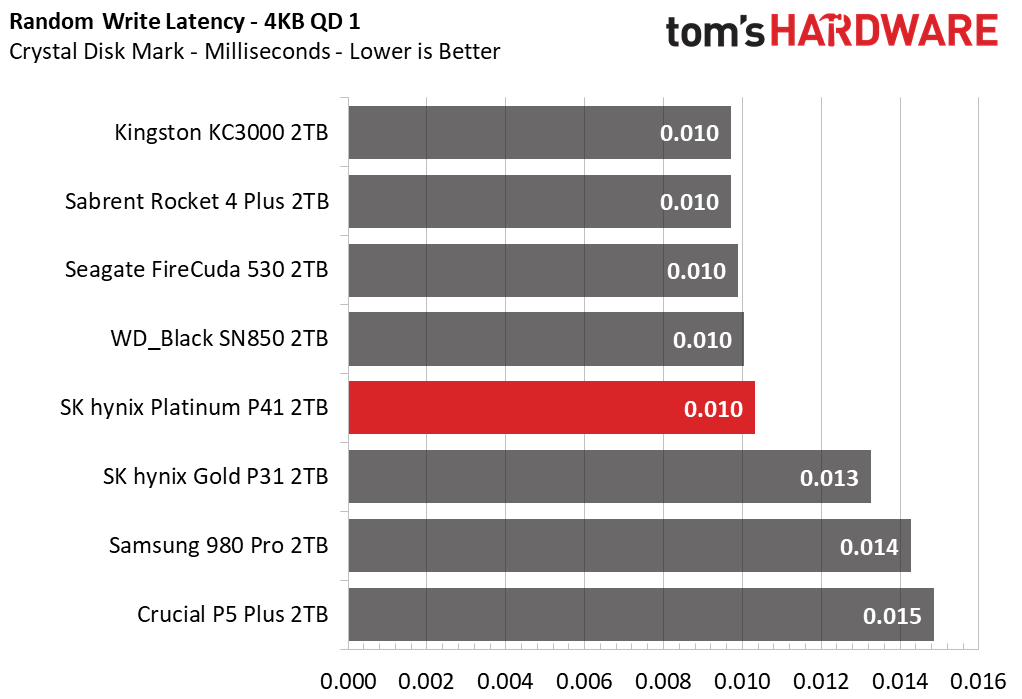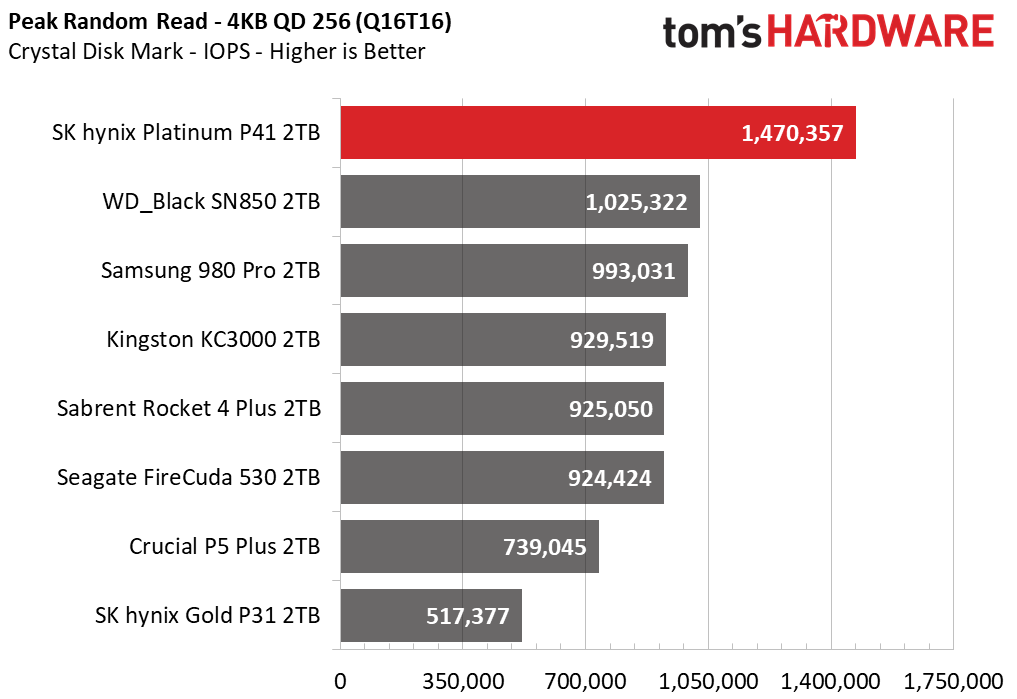Why you can trust Tom's Hardware
2TB SK hynix Platinum P41
RATING: ★★★★ 1/2 (4.5 Stars)
PROS
+ Class-leading all-around performance
+ Competitive performance in sustained workloads
+ Class-leading power efficiency
+ Competitive pricing
CONS
- Runs hot; no heatsink
- No 4TB option yet
OUR VERDICT
The SK hynix Platinum P41 delivers on expectations with unrivaled performance and power efficiency. It’s the best consumer PCIe 4.0 SSD we’ve tested to date, proving that a winning formula can be made even better.
Get Tom's Hardware's best news and in-depth reviews, straight to your inbox.
Comparison Products
The 2TB Platinum P41 is to be compared against other high-end PCIe 4.0 drives at the same capacity, as well as its Gold P31 predecessor. This includes the proprietary controller drives of the WD Black SN850, the Crucial P5 Plus, and the Samsung 980 Pro. Other drives tested use Phison’s E18 controller coupled with 176-layer Micron TLC, the fastest variant but with some differences in caching and optimization between models. These drives include the Kingston KC3000, the Seagate FireCuda 530, and the Sabrent Rocket 4 Plus.
Trace Testing - 3DMark Storage Benchmark
Built for gamers, 3DMark’s Storage Benchmark focuses on real-world gaming performance. Each round in this benchmark stresses storage based on gaming activities including loading games, saving progress, installing game files, and recording gameplay video streams.



The Platinum P41 tops all three charts in this test, demonstrating that SK hynix has certainly focused on optimization. Drives using Phison’s E18 controller with Micron’s 176-layer TLC are not too terribly far behind.
Trace Testing – PCMark 10 Storage Benchmark
PCMark 10 is a trace-based benchmark that uses a wide-ranging set of real-world traces from popular applications and everyday tasks to measure the performance of storage devices.



The Platinum P41 dominates here, too, which is not unexpected. This test tends to favor the P5 Plus and SN850, which nonetheless are significantly behind the P41.
Transfer Rates – DiskBench
We use the DiskBench storage benchmarking tool to test file transfer performance with a custom, 50GB dataset. We copy 31,227 files of various types, such as pictures, PDFs, and videos to a new folder and then follow-up with a reading test of a newly-written 6.5GB zip file.


This bandwidth-heavy test caps the PCIe 4.0 drives with the read workload, but we see the Platinum P41 pull ahead of the pack during the file copy tasks. The controller and flash combination are fast, exceeding even Phison E18-equipped drives which are optimized for this type of performance.
Synthetic Testing - ATTO / CrystalDiskMark
ATTO and CrystalDiskMark (CDM) are free and easy-to-use storage benchmarking tools that SSD vendors commonly use to assign performance specifications to their products. Both of these tools give us insight into how each device handles different file sizes.














While the Platinum P41 does not break records in ATTO — it’s hard to match drives with the E18 and 176-layer flash in these sequential tests — it remains more than competitive on the whole. This is also true of Crystal Disk Mark’s sequential tests, which with QD (Queue Depth) 8 is limited by the x4 PCIe 4.0 interface. With QD1, the Platinum P41 clearly takes the lead with reads but dips closer to the SN850 and P5 Plus with writes. Nevertheless, this is a strong showing overall.
The Platinum P41 is also competitive in Crystal Disk Mark’s random performance tests. We again see a bit of disparity when looking at the very high QD256 results, as the drive dominates with reads but falls behind a bit with writes. Most users look at low queue depth, random results to get an idea of general performance, which is valid, but the Platinum P41’s strengths here do imply some interesting things. For one, it really can hit 1.4M+ IOPS with reads, but the QD1 sequential read test is also quite high. These metrics may become more important once the DirectStorage API matures. As such, this is a future-looking drive.
Sustained Write Performance and Cache Recovery
Official write specifications are only part of the performance picture. Most SSDs implement a write cache, which is a fast area of (usually) pseudo-SLC programmed flash that absorbs incoming data. Sustained write speeds can suffer tremendously once the workload spills outside of the cache and into the "native" TLC or QLC flash. We use Iometer to hammer the SSD with sequential writes for 15 minutes to measure both the size of the write cache and performance after the cache is saturated. We also monitor cache recovery via multiple idle rounds.





The Platinum P41 writes at up to 6.6 GBps for almost 50 seconds, suggesting a total cache size of around 325GB (the initial response indicates a slightly slower static portion at 5.35 GBps). After that, it continues at 1.7 GBps for a while before having a bit of a rebound. This puts its peak closer to the drives using Phison’s E18 controllers but with slower speeds after the pSLC cache is exhausted. Nevertheless, it is still a good response compared to the 980 PRO, P5 Plus, and SN850.
It’s possible SK hynix could get more out of this hardware at 4TB. Otherwise, the design decision indicates the company had this performance target in mind as it provides a good balance. In addition, the drive never hits a bottom performance state, as you eventually may find with Micron’s comparable B47R TLC flash, so it is potentially more consistent in edge cases.
The 2TB Platinum P41 has a hybrid cache like its predecessor, with both static and dynamic pSLC portions. SK hynix has marketed this as Hyperwrite. Static and dynamic caches do work differently and have slightly different origins, with SanDisk - now under WD’s umbrella - and Micron patenting static and dynamic pSLC schemes as nCache and Dynamic Write Acceleration (DWA), respectively. Samsung’s TurboWrite was an original hybrid scheme, but many others have taken a page from that playbook. This scheme offers some flexibility to the user.
Like the Gold P31, the Platinum P41’s pSLC cache recovery was relatively quick for the static portion and slow with the dynamic. Samsung’s TurboWrite, as a point of comparison, was designed to work in a first-in, first-out (FIFO) fashion, with the static cache being filled first. This is not always ideal as you want to balance the endurance of the static pSLC with the native-dynamic portion of flash, particularly as random writes prefer pSLC for performance and endurance reasons. Caching schemes, as such, continue to get more complex as drives accelerate.
Power Consumption and Temperature
We use the Quarch HD Programmable Power Module to gain a deeper understanding of power characteristics. Idle power consumption is an important aspect to consider, especially if you're looking for a laptop upgrade as even the best ultrabooks can have mediocre storage.
Some SSDs can consume watts of power at idle while better-suited ones sip just milliwatts. Average workload power consumption and max consumption are two other aspects of power consumption, but performance-per-watt is more important. A drive might consume more power during any given workload, but accomplishing a task faster allows the drive to drop into an idle state more quickly, ultimately saving energy.
We also monitor the drive’s temperature via the S.M.A.R.T. data and an IR thermometer to see when (or if) thermal throttling kicks in and how it impacts performance. Remember that results will vary based on the workload and ambient air temperature.




Those wanting to see how the Platinum P41 fares with power efficiency do not have to look any further. Not only does it beat the other PCIe 4.0 drives, it even exceeds the class-leading numbers put up by the Gold P31. The Gold P31 does have lower peak and average power draw, but the Platinum P41 can finish tasks far faster. The Gold P31 also has lower idle power consumption with ASPM/LPM disabled.
Testing power efficiency with more-nuanced tests might produce different results, but many users buy PCIe 4.0 drives for the raw bandwidth. Consumer workloads are generally pretty light and quick, with lots of idle time. Therefore, the value of power efficiency for an SSD is questionable past a certain point; however, we can get some idea with a quick copy test like this. The Platinum P41 is simply the most efficient of the high-end PCIe 4.0 drives to date.
The Platinum P41’s S.M.A.R.T. report shows two throttle points, at 86C for throttle and 87C for critical. In practice, we saw throttling around the 84-86C range as measured by the sensor, which corresponded to a 70-72C range for the NAND. During a write workload, we recorded the surface temperature at about 85C versus 82C reported by the sensor, so reports of the drive throttling by 90C, on FLIR, are accurate. We were able to find some relatively graceful throttling after writing about 420GB.
Consumer NAND flash is usually rated for a 0-70C operating range - the idea that NAND works better at higher temperatures must be taken within context. We do recommend that users equip this drive with a heatsink, if possible. This is especially true if you expect the drive to dwell in a warmer environment.
Test Bench and Testing Notes
| CPU | Intel Core i9-11900K |
| Motherboard | ASRock Z590 Taichi |
| Memory | 2x8GB Kingston HyperX Predator DDR4 5333 |
| Graphics | Intel UHD Graphics 750 |
| CPU Cooling | Alphacool Eissturm Hurricane Copper 45 3x140mm |
| Case | Streacom BC1 Open Benchtable |
| Power Supply | Corsair SF750 Platinum |
| OS Storage | WD_Black SN850 2TB |
| Operating System | Windows 10 Pro 64-bit 20H2 |
We use a Rocket Lake platform with most background applications such as indexing, windows updates, and anti-virus disabled in the OS to reduce run-to-run variability. Each SSD is prefilled to 50% capacity and tested as a secondary device. Unless noted, we use active cooling for all SSDs.
Conclusion
Expectations for this drive were high and, it’s nice to say, were generally met or exceeded. SK hynix’s 176-layer TLC has proven itself a contender, and the company's Aries controller offers excellent performance as well. All of this makes for an exceptional product that is competitive in almost every area, even against optimized products. It should make Crucial want to work even harder on improving their P5 and P5 Plus SSDs. On top of the performance accolades, the Platinum P41 also takes the power efficiency throne from the Gold P31, a nice cherry on top.
The Platinum P41 is also priced right where it matters, at 1TB and 2TB. PCIe 4.0 drives have become more affordable as the install base has widened, and that will continue to be the case, especially as PCIe 5.0-capable motherboards and CPUs are on the horizon. However, for the time being, this drive simply beats every alternative in one or more ways. This overall balance — without any stark weaknesses — makes it impossible to score the drive equally with any other PCIe 4.0 drive we’ve tested. This may change in the future, we have yet to see the SM2264 in action, for example, but for now, this is the crème de la crème.
Would we like to see a 4TB option? Yes, that may be forthcoming, but most users are fine with 1TB or 2TB. Would a heatsink be nice? Yes, but it is not always necessary, and we would prefer not to have a built-in heatsink; a separate one which could be optionally applied would add unnecessary cost. Lastly, sustained performance is less than we’ve seen on some B47R drives, but only in the middle state. SK hynix’s Hyperwrite is a balanced design, and we think its strong read performance will be more applicable down the road.
Our primary concern with this drive is availability. The Gold P31 has remained difficult to find in many regions, and it’s often expensive in places that manage to have some stock. However, users in the United States generally got to enjoy that drive and should be able to find this one, too. We hope that SK hynix can ramp up production and availability so that everyone can enjoy this superlative drive. The Platinum P41 is definitely an SSD that you'll want in your system.
MORE: Best SSDs
MORE: How We Test HDDs And SSDs
MORE: All SSD Content

Shane Downing is a Freelance Reviewer for Tom’s Hardware US, covering consumer storage hardware.
-
WrongRookie Isn't this nearly the same price as the silicon x power one?Reply
Anyways, good to see this one doing great...assuming you can get one -
lukemcd I'm a little surprised by the availability comments as a US reader because I've been able to purchase the P31 basically at-will.Reply
Also -- this isn't a big thing, but while both DDR4 and LPDDR4 have similar comparative characteristics to DDR3 and LPDDR3 respectively, implying that this is a transitive property is a bit misleading. The standards have very little to do with each other. -
WrongRookie Replylukemcd said:I'm a little surprised by the availability comments as a US reader because I've been able to purchase the P31 basically at-will.
SSDs are usually available everywhere but for some reason some are exclusive in western territories. In this case, SK Hynix SSDs are like never known in my hometown... -
Alvar "Miles" Udell The real question is why Samsung has increased the price of the 980 Pro 2TB by $30 since the P41 released...Reply -
saunupe1911 Would its high physical temps be OK in a laptop chassis?Reply
I may add a 2TB to my Razor 14. -
LastStanding Replyand we would prefer not to have a built-in heatsink; a separate one which could be optionally applied would add unnecessary cost.
Interesting review. But, I understand this is just your opinion, this opinion should not be the rule, though. Especially, for many consumers that lives in scorched territories and a inexpensive heatsink added (probably an extra ~1-7 bucks in BOM costs) shouldn't break the bank for these companies to add confidence to their customers.
80°C+ is pushing danger zones and what happens if that user were to use this drive in more confined hardware e.g. PS5? 🤔 -
WrongRookie ReplyLastStanding said:Interesting review. But, I understand this is just your opinion, this opinion should not be the rule, though. Especially, for many consumers that lives in scorched territories and a inexpensive heatsink added (probably an extra ~1-7 bucks in BOM costs) shouldn't break the bank for these companies to add confidence to their customers.
80°C+ is pushing danger zones and what happens if that user were to use this drive in more confined hardware e.g. PS5? 🤔
M.2 drives like this one have a thin sheet that does cool down the heat.
Z4-Tml7y1TMView: https://youtu.be/Z4-Tml7y1TM
